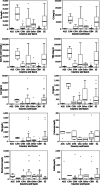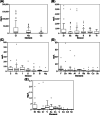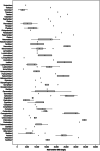The Acute Toxicity of Salinity in Onshore Unconventional Gas Waters to Freshwater Invertebrates in Receiving Environments: A Systematic Review
- PMID: 36193756
- PMCID: PMC9828407
- DOI: 10.1002/etc.5492
The Acute Toxicity of Salinity in Onshore Unconventional Gas Waters to Freshwater Invertebrates in Receiving Environments: A Systematic Review
Abstract
Industries such as unconventional natural gas have seen increased global expansion to meet the increasing energy needs of our increasing global population. Unconventional gas uses hydraulic fracturing that produces significant volumes of produced waters, which can be highly saline and pose a toxic threat to freshwater invertebrates if exposure via discharges, spills, leaks, or runoff were to occur. The primary aim of the present review was to determine the sodium (Na+ ) and chloride (Cl- ) content of these waters as an approximate measure of salinity and how these values compare to the NaCl or synthetic marine salt acute toxicity values of freshwater invertebrate taxa. Shale gas produced waters are much more saline with 78 900 ± 10 200 NaCl mg/L and total dissolved solids (TDS) of 83 200 ± 12 200 mg/L compared to coal bed methane (CBM) produced waters with 4300 ± 1100 NaCl mg/L and TDS of 5900 ± 1300 mg/L and pose a far greater toxicity risk from NaCl to freshwater invertebrates. In addition, the toxicity of other major ions (Ca2+ , K+ , Mg2+ , , HCO3 - , and ) and their influence on the toxicity of Na+ and Cl- were evaluated. Exposure of untreated and undiluted shale gas produced waters to freshwater invertebrates is likely to result in significant or complete mortality. Shale gas produced waters have higher concentrations of various metals compared with CBM produced waters and are more acidic. We recommend future research to increase the reporting and consistency of water quality parameters, metals, and particularly organics of produced waters to provide a better baseline and help in further investigations. Environ Toxicol Chem 2022;41:2928-2949. © 2022 The Authors. Environmental Toxicology and Chemistry published by Wiley Periodicals LLC on behalf of SETAC.
Keywords: Acute toxicity; freshwater invertebrates; hydraulic fracturing; produced water; salinity; unconventional gas.
© 2022 The Authors. Environmental Toxicology and Chemistry published by Wiley Periodicals LLC on behalf of SETAC.
Conflict of interest statement
The authors declare that they have no known competing financial interests or personal relationships that could have appeared to influence the work reported in the present study.
Figures









Similar articles
-
Signs and symptoms to determine if a patient presenting in primary care or hospital outpatient settings has COVID-19.Cochrane Database Syst Rev. 2022 May 20;5(5):CD013665. doi: 10.1002/14651858.CD013665.pub3. Cochrane Database Syst Rev. 2022. PMID: 35593186 Free PMC article.
-
"Eco-friendly" road deicers may not be so friendly: assessing the toxicity of beet-juice brine and potassium chloride to Daphnia pulicaria.Environ Toxicol Chem. 2025 Aug 1;44(8):2089-2097. doi: 10.1093/etojnl/vgaf110. Environ Toxicol Chem. 2025. PMID: 40279480
-
Comparison of cellulose, modified cellulose and synthetic membranes in the haemodialysis of patients with end-stage renal disease.Cochrane Database Syst Rev. 2001;(3):CD003234. doi: 10.1002/14651858.CD003234. Cochrane Database Syst Rev. 2001. Update in: Cochrane Database Syst Rev. 2005 Jul 20;(3):CD003234. doi: 10.1002/14651858.CD003234.pub2. PMID: 11687058 Updated.
-
Sertindole for schizophrenia.Cochrane Database Syst Rev. 2005 Jul 20;2005(3):CD001715. doi: 10.1002/14651858.CD001715.pub2. Cochrane Database Syst Rev. 2005. PMID: 16034864 Free PMC article.
-
Salinity-induced ionoregulatory changes in the gill proteome of the mayfly, Neocloeon triangulifer.Environ Pollut. 2023 Jan 1;316(Pt 2):120609. doi: 10.1016/j.envpol.2022.120609. Epub 2022 Nov 8. Environ Pollut. 2023. PMID: 36368556 Free PMC article.
Cited by
-
Study on Demulsification via Vacuum Filtration with Superamphiphilic Diatomite/G-C3N4/Rice Husk Charcoal Composite Filter Layer.Nanomaterials (Basel). 2025 Feb 22;15(5):344. doi: 10.3390/nano15050344. Nanomaterials (Basel). 2025. PMID: 40072147 Free PMC article.
-
Chronic toxicity of dissolved barium and sodium chloride to the water flea Ceriodaphnia dubia: implications for unconventional gas flowback-produced waters.Environ Toxicol Chem. 2025 Jan 1;44(1):169-183. doi: 10.1093/etojnl/vgae019. Environ Toxicol Chem. 2025. PMID: 39887277 Free PMC article.
-
Mixture Toxicity of Three Unconventional Gas Fracking Chemicals, Barium, O-Cresol, and Sodium Chloride, to the Freshwater Shrimp Paratya australiensis.Environ Toxicol Chem. 2023 Feb;42(2):481-494. doi: 10.1002/etc.5538. Epub 2023 Jan 13. Environ Toxicol Chem. 2023. PMID: 36511521 Free PMC article.
References
-
- Abousnina, R. M. , Nghiem, L. D. , & Bundschuh, J. (2015). Comparison between oily and coal seam gas produced water with respect to quantity, characteristics and treatment technologies: A review. Desalination and Water Treatment, 54(7), 1793–1808. 10.1080/19443994.2014.893541 - DOI
-
- Ahamed, M. A. A. , Perera, M. S. A. , Matthai, S. K. , Ranjith, P. G. , & Li, D.‐y. (2019). Coal composition and structural variation with rank and its influence on the coal‐moisture interactions under coal seam temperature conditions—A review article. Journal of Petroleum Science and Engineering, 180, 901–917. 10.1016/j.petrol.2019.06.007 - DOI
-
- Alessi, D. S. , Zolfaghari, A. , Kletke, S. , Gehman, J. , Allen, D. M. , & Goss, G. G. (2017). Comparative analysis of hydraulic fracturing wastewater practices in unconventional shale development: Water sourcing, treatment and disposal practices. Canadian Water Resources Journal/Revue Canadienne Des Ressources Hydriques, 42(2), 105–121. 10.1080/07011784.2016.1238782 - DOI
-
- Al‐Ghouti, M. A. , Al‐Kaabi, M. A. , Ashfaq, M. Y. , & Da'na, D. A. (2019). Produced water characteristics, treatment and reuse: A review. Journal of Water Process Engineering, 28, 222–239. 10.1016/j.jwpe.2019.02.001 - DOI
Publication types
MeSH terms
Substances
LinkOut - more resources
Full Text Sources
Miscellaneous

